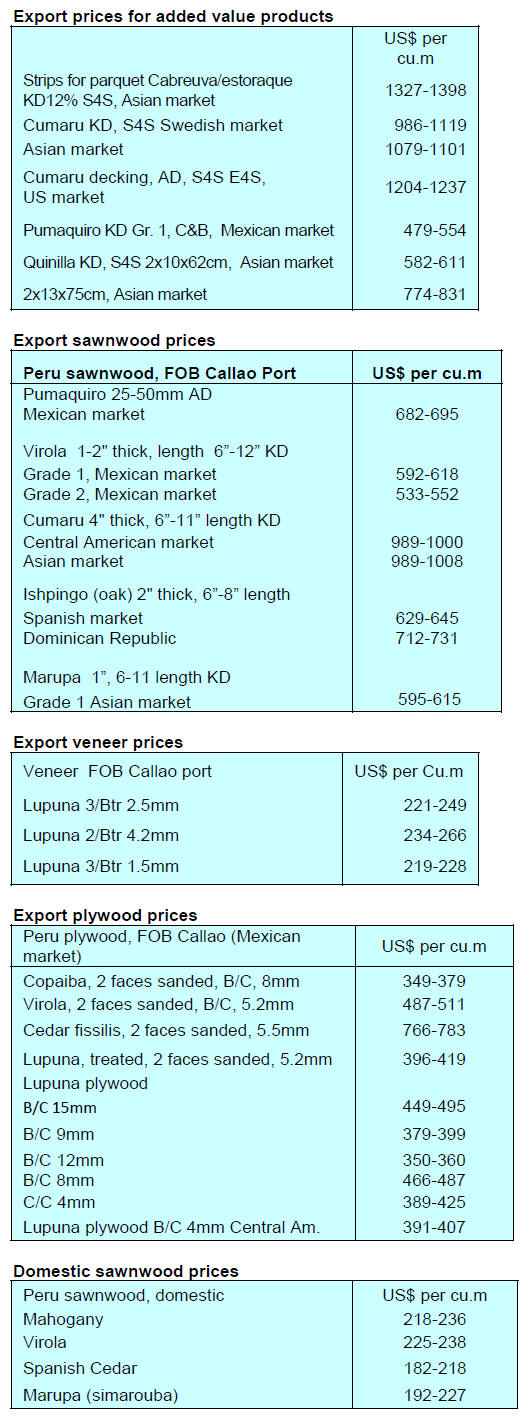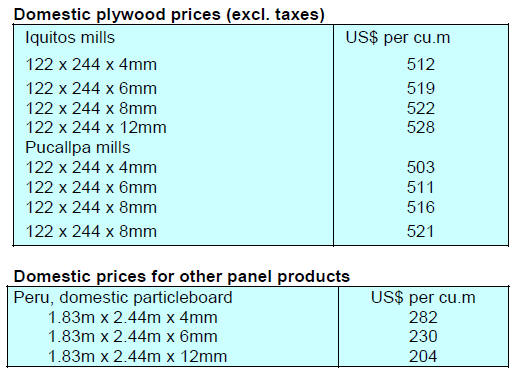4.
INDONESIA
SVLK rebranded
The European Union's decision to impose new rules
regulating the timber trade has pushed Indonesia to act. On
1 March 2023 the Ministry of Environment and Forestry
(KLHK) finalised a ‘new’ SVLK. The SVLK has changed
to the ‘Legality and Sustainability Verification System’
with the same abbreviation, SVLK.
This new regulation deals with the legality of timber
sources and identifies the sources that are sustainably
managed.
The Director General of Sustainable Forest
Management
in the KLHK, Agus Justianto, when speaking at a seminar
held by the Indonesian Timber Panel Association
(Apkindo), said the previous SVLK also had sustainability
aspects in its criteria and indicators. With the word
sustainability (for the new SVLK), now emphasises
legality and sustainability, he said.
According to Agus, the SVLK has evolved to include, for
example, a longer validity period for certificates for
cultivated wood. There are also financing facilities for
certification for micro, small and medium enterprises.
He added that the government's quick action in rebranding
the SVLK should be appreciated as it deals with market
requirements as the EU wood product market is large and
Indonesia must act to capture a greater market share.
See:
https://agroindonesia.co.id/svlk-baru-perkuat-kelestarian/
New paradigm for SVLK
The Director for Processing and Marketing of Forest
Products at the KLHK, Krisdianto, said that the SVLK
was well accepted in the international market adding that
the SVLK has a number of attributes that make it
acceptable. Among them is that the SVLK has strict and
well-maintained regulations to ensure the forest product
legality and forest sustainability.
The multi-stakeholder involvement in the development
and implementation is also an attribute that strengthens the
SVLK. In addition, the SVLK is credible because
verification is carried out by third parties which are
accredited by the National Accreditation Committee
(KAN).
Implementation of the SVLK is transparent because it
involves civil society as independent monitors.
Responding to the European Union's plan to implement
the Deforestation Free Supply Chain law, Krisdiyanto
stated that Indonesia hopes that the European Union will
continue to recognise the SVLK.
The chairman of the Indonesian Forestry Community
Communication Forum (FKMPI), Indroyono Soesilo,
stated the SVLK is a credible system for Indonesia to
satisfy the European Union's DFSC regulations. This is
because the SVLK increases accountability and
transparency which have an impact on improving forest
governance in Indonesia.
See:
https://agroindonesia.co.id/svlk-paradigma-baru-bisamenjawab/
EUDR taken up at FACT Dialogue
At the opening of the Forest, Agriculture Commodities
Trade (FACT) Retreat held in London the Deputy Minister
of Environment and Forestry, Alue Dohong, conveyed
Indonesia's stance regarding the European Union's Due
Diligence Regulations.
He said the European Union's due diligence regulations on
six commodities, especially wood products ignores
Indonesia's efforts to implement a Legality and
Sustainability Legality Verification System (SVLK) which
has been in operation since 2001 within the framework of
Forest Law Enforcement Governance and Trade (FLEGT).
In his opening speech, Alue conveyed Indonesia's views
on the EU's due diligence regulations and hoped that the
FACT Dialogue could support Indonesia's stance in
anticipating these due diligence regulations. The European
Union is a member of the FACT Dialogue.
Alue also said that the FACT Dialogue should not only be
a 'talk platform' but should pay attention to solving nontariff
barriers problems.
The FACT Dialogue is a 28-country dialogue forum
consisting of groups of producing countries and groups of
consuming countries that have the goal of agreeing on
principles of collaborative action, a common roadmap on
sustainable land use and international trade and taking
steps to protect forests while promoting development and
trade.
See:
http://ppid.menlhk.go.id/berita/siaran-pers/7118/dipembukaan-fact-retreat-wamen-lhk-sampaikan-sikap-indonesiaterhadap-regulasi-uji-tuntas-uni-eropa
and
https://forestinsights.id/2023/03/30/wamen-lhk-sampaikan-sikapindonesia-soal-eu-dfsc-di-fact-retreat-campakkan-usahamembangun-svlk/
Plywood producers and IFCC/PEFC certification
Indonesian plywood producers are considering the IFCCPEFC
certification scheme in order to strengthen
penetration into the export market as well as to support
sustainable forest management.
The Chairman of Apkindo, Bambang Soepijanto, stated
that the certification scheme developed by the Indonesia
Forestry Certification Cooperation (IFCC)-Program for
Endorsement Forestry Certification (PEFC) is attractive to
Apkindo members because it can increase economic
growth and guarantee environmental sustainability.
Another benefit of the IFCC-PEFC scheme is that it can
already be carried out by domestic audit institutions with
accreditation from the National Accreditation Committee
(KAN). This will have an impact on time and cost
efficiency in the certification process.
The Secretary General of the National Accreditation
Committee (KAN), Donny Purnomo, revealed that KAN
has operated the IFCC-PEFC accreditation scheme since
2022. He explained that one of the requirements for
certification bodies intending to obtain KAN accreditation
for IFCC-PEFC is that they must have received
accreditation for the mandatory SVLK scheme.
See:
https://forestinsights.id/2023/03/24/produsen-kayu-lapislirik-sertifikasi-ifcc-pefc-akreditasi-kan-jadi-satu-alasan/
Rational behind carbon pricing
Director General of Climate Change Control at the
Ministry of Environment and Forestry, Laksmi Dewanthi,
stated that the main goal of developing Economic Carbon
Value (NEK) is not just about money because article 6 of
the Paris Agreement and Presidential Decree 98 of 2021
clearly indicates the aim of NEK is to achieve the NDC
target,"
She explained that, to support the achievement of the
NDCs, it is necessary to seure funding. One source of
funds is the development of the NEK and developing an
inclusive, transparent and fair carbon market.
Currently, the government is preparing to operationalise
carbon trading. The regulations are being prepared by the
KLHK concerning Procedures for Carbon Trading in the
Forestry Sector and regulations concerning
implementation of NDCs. The KLHK, together with the
Financial Services Authority (OJK), are preparing
regulations regarding technical arrangements for a carbon
exchange.
See:https://forestinsights.id/2023/03/25/klhk-tegaskan-tujuanutama-carbon-pricing-bukan-ekonomi-regulasi-disiapkan/
Downstream industry investment forecasts
The Ministry of Investment has forecast that Indonesia’s
ambitious downstream aims would require an investment
of around US$550 billion over the next two decades.
About US$432 billion in investment needs be directed to
the minerals and coal sectors. The industrial downstream
sectors will need US$68 billion and investment needs in
plantations, fisheries and forestry sectors total US$45
billion.
See:
https://jakartaglobe.id/business/indonesias-downstreamindustry-plan-needs-5453b-till-2040
KLHK-MA collaborate on environmental protection and
forestry
The KLHK is strengthening cooperation in the legal field
with the Supreme Court (MA) to build a firm legal
foundation for environmental and forest protection in
Indonesia. The signing of a memorandum of
understanding was done by the Secretary General of the
Ministry of Environment and Forestry, Bambang
Hendroyono, with the Secretary of the Supreme Court,
Hasbi Hasan.
"The memorandum of understanding is the basis for
implementing coordination between the two institutions in
supporting efforts to protect the environment and forestry
in realising sustainable development and actualising
community rights according to constitutional mandates,
said KLHK Minister, Siti Nurbaya.
See:
https://www.antaranews.com/berita/3452517/klhk-maberkolaborasi-wujudkan-perlindungan-lingkungan-kehutanan-ri
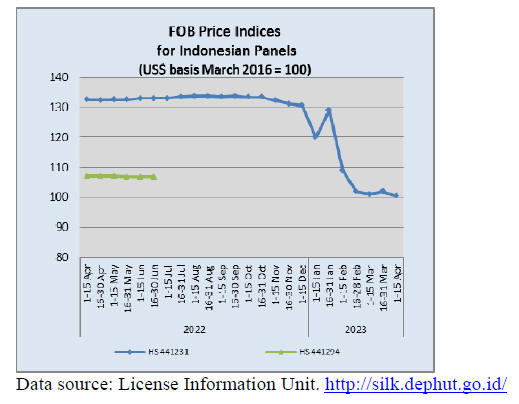
Through the eyes of industry
The latest GTI report lists the challenges identified by the
private sector in Indonesia.
See:
https://www.ittoggsc.org/static/upload/file/20230414/1681442042214477.pdf
5.
MYANMAR
The domestic press quoting the recent National
Planning
Law 2023-2024 says the governments aim is to lift per
capita GDP to MMK2.45 (about US$1,160). This would
involve an increase by MMK400,000 from the 2022-2023
financial year level.
The National Planning Law took effect on 1 April and
forecasts a rise of 4% in GDP. The legislation provides for
more than MMK8,300 billion to be invested by the State
for projects that benefit the State and citizens. In the
previous national plan the average per capita GDP was
targeted to increase from MMK2,052,528 to
MMK2,222,230.
In the current National Planning Law the participation of
the agricultural sector, the industrial sector and the
services sector in the total value of gross domestic product
are expected to reach 2.5%, 4.8% and 6.7%.
See:
https://www.gnlm.com.mm/myanmar-aims-to-achieve-anaverage-per-capita-gdp-of-k2-45-million/
Deadline for transfer of export earnings
The Central Bank of Myanmar (CBM) is pushing
exporters to show receipts of export earnings in the
prescribed time.
According to the local media the chairperson of the CBM
held a meeting with Deputy Minister of Commerce,
Chairman of Union of Myanmar Federation of Chamber of
Commerce and Industries (UMFCCI) and Director of
Special investigation on this issue.
Under the current rules exporters are required to complete
the transfer of export earnings back to banks in Myanmar
within 45 days for exports to Asian countries and 90 days
for other markets.
The CBM is trying to stabilise the exchange rate
which
has fluctuated reaching 3500 MMK per US dollar in the
second and third quarters of 2022 and is now around 2900
MMK. However, the CBM official exchange rate is 2100
MMK per US dollar.
In order to stabilise the exchange rate the CBM seems to
be preparing to strengthen the regulation which will assure
the export earning deposited in the prescribed time.
See:
https://www.cbm.gov.mm/content/7926
6.
INDIA
Economy resilient and well positioned
to face
challenges
In its Monthly Bulletin for March the Reserve Bank of
India (RBI) said the economy is resilient and well
positioned to face a global growth slowdown as the
country has emerged from the pandemic years stronger
than initially thought.
The RBI bulletin says “Broader economic activity has
remained resilient and poised to expand further. Domestic
demand is accelerating with auto sales having rebounded,
real estate sales on the rise in spite of a pick-up in
borrowing costs and the contact-intensive hospitality
services experiencing a bounce-back. Bank credit is
increasing by double digits and the sustained surge in
goods and service tax collections is signalling growing
formalisation of the economy.
Indian equities are outperforming both advanced and
emerging peers. Selling by foreign portfolio investors is
being more than matched by domestic institutional
investors’ buying. Corporate and bank balance sheets have
become fortified through the period of the pandemic”.
As the third largest economy in terms of purchasing power
parities, India accounts for 3.6 % of G20 GDP. In 2023,
India is projected to be among the fastest growing
economies within G20.
See:
https://www.rbi.org.in/Scripts/BS_ViewBulletin.aspx?Id=21332
and
https://www.drishtiias.com/daily-updates/daily-newsanalysis/state-of-the-economy-report-rbi
Slower income growth to hold down economy
India’s GDP growth is expected to moderate to 6.3% in in
fiscal 2024 due to decline in consumption according to a
World Bank report. The Bank lowered its forecast for
India's economic growth in the current fiscal year.
India’s growth for 2023-24 is forecast to be lower due to
concerns on the global economy and because of rising
borrowing costs and slower income growth leading to a
moderation in consumption.
See:
https://www.hindustantimes.com/india-news/world-bankand-adb-cut-india-s-growth-projections
Rupee weakened as interest rates held steady
The Reserve Bank of India kept the interest rate at 6.50%
after six straight hikes which surprised analysts who were
anticipating a rise. The Indian rupee weakened slightly
after the announcement. The slowing rate increases came
despite inflation remaining above the target maximum of
6%.
See:
https://asia.nikkei.com/Economy/India-pauses-rate-hikes-insurprise-move-amid-stubborn-inflation
Bright outlook for housing
It is reported that India Ratings and Research (Ind-Ra) has
revised the outlook for the residential real estate sector for
fiscal 2024. Ind-Ra reports that house prices rose 8–10%
this fiscal year and may further increase by 5% this year.
See:
https://www.indiaratings.co.in/rating-details/2/61388
A press release from the IFC says low and middle income
borrowers will be able to own homes with improved
access to finance thanks to a new investment aiming to
boost affordable housing finance in India, while
supporting the country's climate goals by focusing on
green affordable housing.
IFC's US$250 million loan to the Housing Development
Finance Corporation (HDFC), India's largest housing
finance company, will support its affordable housing and
emerging green affordable housing portfolio by improving
access to housing for people on low incomes.
At least 25% of the financing has been earmarked for
green affordable housing which is likely to encourage this
market in India. Green housing is largely regarded as a
luxury market in the country but, given its climate
benefits, IFC intends to challenge that perception and help
boost green affordable housing by partnering with HDFC.
See:
https://pressroom.ifc.org/all/pages/PressDetail.aspx?ID=26526
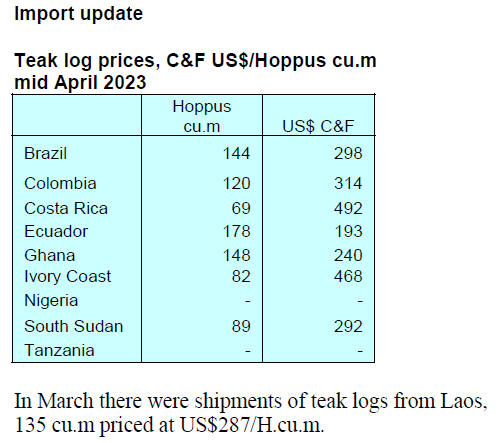

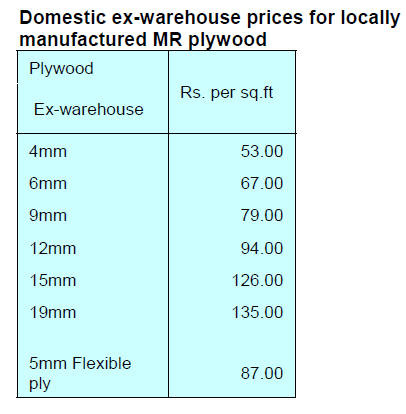
7.
VIETNAM
Wood and Wood Product (W&WP) trade
highlights
According to the General Department of Customs in
March 2023 W&WP exports were valued at US$1.2
billion, up 36% compared to February 2023 but down 23%
compared to March 2022. In particular, WP exports stood
at US$823 million, up 48% compared to February 2023
but down 30% compared to March 2022.
In the first 3 months of 2023 W&WP exports amounted to
US$2.88 billion, down 28% over the same period in 2022.
In particular, WP exports contributed US$1.87 billion,
down 39% over the same period in 2022.
Vietnam's W&WP imports in March 2023 were valued at
US$220 million, up 46% compared to February 2023 but
down 7.6% compared to March 2022. In the first 3 months
of 2023 W&WP imports estimated at US$491 million,
down 28% over the same period in 2022.
Imports of logs and sawnwood in March 2023 were
415,500 cu.m, worth US$147.5 million, up 28% in volume
and 27% in value compared to February 2023. However,
compared to March 2022 imports decreased by 7% in
volume and 12% in value.
In the first 3 months of 2023 imports of logs and
sawnwood are estimated at 973,600 cu.m, worth US$350.9
million, down 21% in volume and 25% in value over the
same period in 2022.
Exports of NTFPs in March 2023 contributed US$70
million, up 24% compared to February 2023, down 22%
compared to March 2022. Overall, in the first quarter of
2023, NTFP exports generated US$172.42 million, down
35% over the same period in 2022.
W&WP exports to the EU markets in March 2023
accounted for US$55.2 million, down 26% compared to
March 2022.
In March 2023 exports of kitchen furniture brought
in
about US$89.4 million, down 29% compared to March
2022. Kitchen furniture exports in the first 3 months of
2023 contributed US$216.7 million, down 30% over the
same period in 2022.
Export of wood chips set to decline
The increasing scarcity of energy in many countries
around the world in the past year is the main factor
promoting the good growth of Vietnam's woodchip
exports. In 2023, with the factors affecting export and
domestic woodchip production, it is not expected that the
price "fever" will last.
Fluctuations in chip markets
According to Nguyen Quoc Tri, Deputy Minister of
Agriculture and Rural Development, in 2022 despite many
changes, the wood and forest product processing industry
still achieved more than US$17 billion in exports. While
the growth rate of 7% in 2022 was the lowest figure in the
past ten years it still shows that Vietnam is one of the
important suppliers for international customers.
In 2022 the export of wood chips reached 15.8 million
tonnes, up 16% compared to 2021. The export value
reached nearly US$2.8 billion, up more than 60% over the
same period last year. The expansion of woodchip export
earnings in recent years is mainly due to the sharp increase
in prices.
The average price in 2022 increased by more than 38%
compared to 2021. The FOB export price increased from
about US$130/tonne at the beginning of the year to a
record level of more than US$200/tonne in the period of
August - October 2022.
However, since October 2022 chip prices showed signs of
cooling down although it remained at a high level. China
and Japan are the two largest woodchip markets for
Vietnam accounting for nearly 95% of total export volume
and turnover.
Impact factors
According to a report by the Research Group of Wood
Associations and Forest Trends the signals for the
woodchip export markets in 2023 are not clear yet but it
can be seen that a number of factors are affecting the
situation.
Specifically, the export price in 2023 is tending to fall
compared to 2022. The export price in the first months of
2023 is down compared to the previous months.
According to assessment by some businesses this decline
may last until the end of the second quarter of 2023.
In addition, information on chip consumption demand in
major markets such as China, Japan and South Korea is
not clear yet so it is difficult to make accurate assessments
of fluctuations in markets.
However, the demand for woodchips in Japan and South
Korea is forecast to continue to increase in 2023 because
chips are used to replace coal as an input material for
power generation.
The domestic supply of special wood chips and pellets
from Korean furniture production facilities in 2023 may
decrease since these facilities have had to reduce their
production scale because the weakening world economy.
The decline in domestic supply of chips may require
Korea to expand imports in the near future.
Another factor affecting trade is Vietnam's policies on
VAT. The issue of VAT refunds for 2022 exports has not
been resolved.
This has caused many enterprises in the sector to consider
their production and export activities in the future. If some
pull out it will affect export earnings from woodchips.
In 2023 it is anticipated there will no longer be a shortage
of input materials for woodchips as in 2022. The export of
veneers to China market has shown signs of recovery.
Residuesf rom the production of veneers and plywood is
used for chip and pellet production.
See:
https://wtocenter.vn/chuyen-de/21596-export-of-woodchips-will-decline
And
https://en.vcci.com.vn/export-of-wood-pellets-under-downwardpressure
Benefits from a carbon credit market -Reducing
emissions and deforestation
As a country with almost 15 million hectares of forest,
Vietnam’s forestry sector can play an important role in not
only reducing greenhouse gas emissions but also
generating revenue from the market for carbon credits.
Revenue from forest carbon credits could prove to be very
profitable for Vietnam. However, this will require finding
ways to protect these areas and to reduce deforestation.
Planting more trees to increase forest acreage could be one
way to offset the impacts of deforestation.
Many Vietnamese agricultural firms from large
corporations to smaller startups have expressed an interest
in a carbon credit market. Sokfarm, for example, is
looking to sell carbon credits from coconut trees. This may
have the added benefit of reducing hardships and
mitigating risks posed by climate change for farmers.
Quang Nam is the first locality in Vietnam licensed by the
government to carry out a pilot project for developing
forest carbon credits.
Quang Nam’s natural forest area is 466 hectares. If one
cubic meter of forest trees is equal to 1.1 tons of carbon,
after the pilot phase this project could help Quang Nam
earn up to US$5 million per year at a selling price of
US$5/ton carbon dioxide equivalent (CO2e).
Despite billions of dollars being spent on carbon
removal
the profit from selling carbon credits is still not high
enough to persuade a critical mass of owners to
discontinue clearing forests.
This is due to increasing demand for wooden furniture in
both domestic and global markets and high prices as a
result. In the first 11 months of 2022, wood and wooden
products exports of Vietnam were worth an
estimated US$14.6 billion, increasing 9% over the same
period in 2021.
Prospects for Vietnam’s carbon market
Creating a carbon credit market in Vietnam will be highly
beneficial for the carbon capture industry and, more
crucially, the environment.
By reducing greenhouse gas emissions, a successful
carbon trading market will aid Vietnam in fulfilling its
COP26 commitments while enabling individuals and
businesses to profit from selling credits overseas.
Despite the absence of a carbon market in Vietnam at
present, the groundwork is being laid and carbon
emissions management is steadily advancing towards this
goal. The move is not only necessary for Vietnam to
achieve its climate commitments but also to ensure
seamless international trade.
See:
https://www.vietnam-briefing.com/news/vietnams-carbonmarket-2023.html/
Vietnam tries “community forestry” model to protect
forests
To date, 280,000 hectares of the total 15.3 million hectares
of forests have been allocated to local people for forestry
production and 513,000 hectares have been allocated for
management and protection. The figures would be
increasing sharply in the future as local authorities have
realized that Vietnam needs to rely on the community to
protect forests.
Local people can best protect local forests
Reports by local authorities all showed that the forests can
be protected best once responsibility is assigned to local
people. However, a problem still exists in the legal status
of the communities that take the responsibility of
protecting forests and in the unreasonable policies.
Dr. Nguyen Nghia Bien, Director of Institute of Forest
Inventory and Planning noted that communities assigned
to protect forests are mostly ethnic minority people, while
the forests allocated to people are mostly the poor forests
in remote areas with bad infrastructure conditions.
Dr. Pham Xuan Phuong from the Ministry of Agriculture
and Rural Development said in many localities people still
have not received the money for the forest development.
Therefore, they are not encouraged enough to continue the
work of developing the forests.
The Institute of Forest Inventory and Planning is
implementing projects on strengthening community
forestry in Vietnam. Bien emphasized the necessity of
mobilising society’s resources for forest protection and
development.
See:
https://vietnamnet.vn/en/vietnam-tries-community-forestrymodel-to-protect-forests-E92236.html
8. BRAZIL
Sustainable Wood - The future of the
market
A National Forum for the Forest Base (FNBF) which
gathers 23 organisations from the Brazilian forest sector
totalling more than 3,500 associated companies, organised
an event "Sustainable Timber - The future of the market”
to discuss the advantages of forest management.
Wood coming from SFM sources effectively contributes to
the preservation and conservation of Brazilian forests,
fauna and flora. A misunderstanding of the differences
between illegal sources, deforestation and SFM sources
results in many professionals in architecture, urbanisation
and engineering avoiding the use of wood products
believing, by doing so, they will not contribute to
deforestation of the Amazon Forest when the opposite is
the case.
One of the reasons for holding the event was to present
science and knowledge to professionals, interior designers
and dealers who sell wood from natural forests.
The Forum heard that Brazil has the capacity to double its
wood production through SFM. Brazil has 489 million ha.
of forests and of this total 334 million ha. are in the
Amazon biome. The country has 39% of the world's
tropical forests but only 10% of tropical wood
consumption is produced in the country and of this around
3% is exported.
For example, the state of Mato Grosso is responsible for
85% of the sustainable timber production in the country
followed by the state of Pará, with 28% and Rondônia,
20% according to IBAMA. Mato Grosso State alone has
the capacity to double the production of timber from
sustainably managed forests and through this combat
illegal harvesting.
Currently, there are 3 million ha. of production forests
with the possibility to rise to 6 million by 2030 according
to CIPEM.
See:
http://www.forumflorestal.org.br/2023/03/09/arquitetosambientalistas-e-madeireiros-participam-de-evento-para-discutirmanejo-florestal/
Rules governing carbon credits for concession
holders
The House of Representatives has approved a Provisional
Measure 1151/22 which changes the regulations in the
Public Forest Management Law (forest concessions)
allowing non-timber production activities and the
commercialisation of carbon credits.
According to the new regulation, the right to
commercialise carbon credits and other similar
instruments for the mitigation of greenhouse gas emissions
is included along with a mention of participation by the
Brazilian Forest Service (SFB).
Production of non-timber forest products and services may
be another aim of forest concessions as long as they are
carried out in the management unit under the terms of the
regulation. Forest restoration with agroforestry systems
combining native and exotic species of economic and
ecological interest may also be carried out in the
management unit.
An addendum to concession contracts will set the
conditions/requirements and allow for the preparation of a
single Sustainable Forest Management Plan (SFMP) with
the managing agency (SFB) being responsible for making
the necessary adjustment.
See:
https://forestnews.com.br/camara-mp-creditosdcarbono-gestao-de-florestas/
Updated information on African Mahogany in Brazil
The Brazilian Association of African Mahogany Producers
(Associação Brasileira de Produtores de Mogno Africano -
ABPMA) founded in 2011 released updated information
regarding the production of African mahogany in Brazil in
its March 2023 journal.
Information provided includes:
There are large plantations of Khaya grandifoliola, K.
senegalensis as well as K. anthotheca and K. ivorensis
plantations.
The expansion of African mahogany cultivation in Brazil
extends over 9 states but 66% of the forest plantations are
concentrated in the state of Minas Gerais.
Brazil has about 66,300 hectares of planted Khaya. More
specifically: K. grandifoliola: 42,000 ha; K. senegalensis:
23,000 ha; K. anthotheca: 800 ha; K. ivorensis: 500 ha.
The data in the journal are from several producers updated
based on the ABPMA database. The Association reported
that the data provided is an estimate.
See:
https://drive.google.com/drive/folders/1sZLedFP_hUDViGoDCdkegVTxWhWWAlA3?usp=share_link
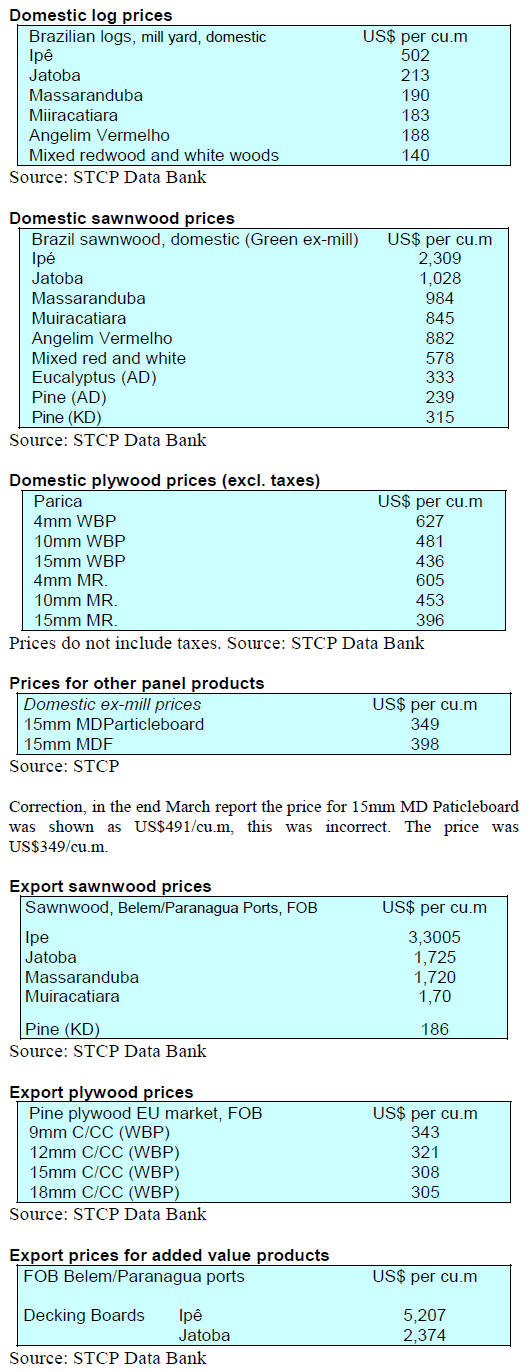
Through the eyes of industry
The latest GTI report lists the challenges identified by the
private sector in Brazil.
See:
https://www.ittoggsc.org/static/upload/file/20230414/1681442042214477.pdf
9. PERU
Serfor provided
timber to repair docks
The Rural Agrarian Productive Development (Agro Rural)
programme received almost 30 cubic metres of sawn
Myroxylon balsam donated by the National Forestry and
Wildlife Service (Serfor) to repair docks on the guano
islands, located in the ports Ancon and Callao.
"The docks in question serve as loading points for Guano
that is then marketed to different farmers in the country”.
Guano from the islands is a 100% organic product that
forms part of the State's natural resources and its
extraction, packaging, distribution and commercialisation
is carried out only by Agro Rural.
New standards for wooden sleepers
Peru has 2,000 kilometers of railways and there is a steady
demand for sleepers for the maintenance of existing tracks
as well as for the development of new lines.
The Ministry of Agrarian Development and Irrigation
(MIDAGRI) recently approved "unpreserved wooden
sleepers for narrow gauge railways" and "unpreserved
wooden sleepers for normal gauge railways" through
Resolution No. 0089-MIDAGRI on March 22 of this year.
This sets out how these products should be made so that
the State can acquire them more quickly and effectively
and can also be offered to other markets.
Forest users in Ucayali and Loreto trained on SFM
regulations
In order to promote compliance with forestry regulations
the Agency for the Supervision of Forest Resources and
Wildlife (OSINFOR) interacted with and advised forest
users in cayali and Loreto on the scope of the forest
supervision and the applications of sustainable
management of forest resources.
OSINFOR held two workshops, the first on 24 March in
the Auditorium of the Pucallpa Bar Association in
Ucayali; while the second took place on 31 March in
Yurimaguas, in the province of Alto Amazonas, Loreto;
The Pucallpa workshop was aimed at holders of forestry
concessions for timber purposes in the Ucayali region.
Native communities trained in the use of drones for
forest surveillance
Representatives of the native communities in Sinchi Roca,
Santa Rosa de Aguaytia, Fernando Sthal and Puerto Belén,
from the Ucayali Region have been trained on the use of
drones to detect and prevent forest crimes in their
communal forests.
In coordination with the Ucayali Regional Forestry and
Wildlife Management (GERFFS) OSINFOR trainers
explained, through the Forest Backpack methodology, the
measures that can be taken to prevent various forest
crimes, file complaint and how to present these complaints
to the corresponding authorities.
